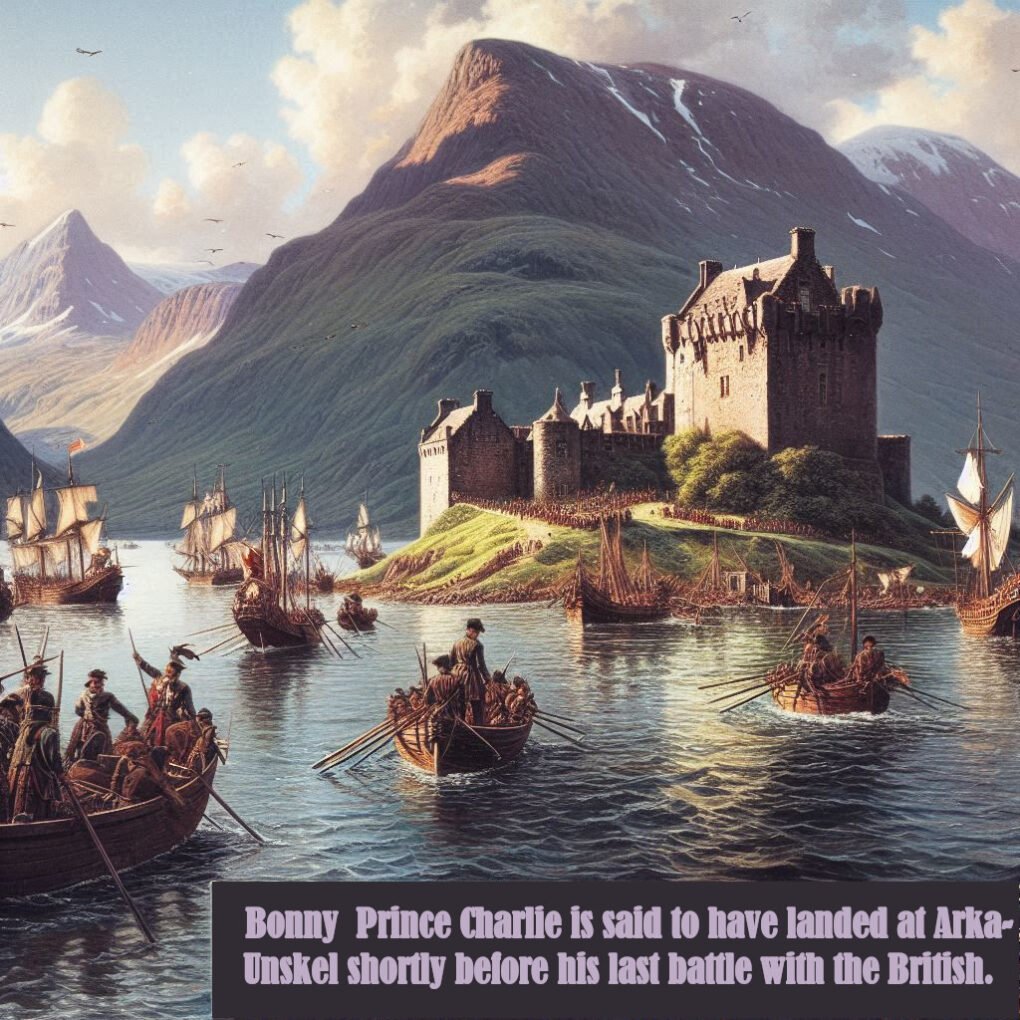Arka-Unskel
Arka Unskel is 2½ miles ESE of Arisaig at NM693839 and has also been known as Ard Ghaunsgoik and Ard Ghamhgail. Described as on a promontory on the north side of Loch nan Uamh with a heavily vitrified wall. – Richard Feachem’s “A guide to Ancient Scotland”
At the point where Loch na Nuagh begins to narrow, where the opposite shore is about one-and-a-half to two miles distant, is a small promontory connected with the mainland by a narrow strip of sand and grass, which evidently at one time was submerged by the rising tide. On the flat summit of this promontory are the ruins of a vitrified fort, the proper name for which is Arka-Unskel.
The rocks on which this fort are placed are metamorphic gneiss, covered with grass and ferns, and rise on three sides almost perpendicular for about 110 feet from the sea level. The smooth surface on the top is divided by a slight depression into two portions. On the largest, with precipitous sides to the sea, the chief portion of the fort is situated, and occupies the whole of the flat surface. It is of somewhat oval form. The circumference is about 200 feet, and the vitrified walls can be traced in its entire length. We dug under the vitrified mass, and there found what was extremely interesting, as throwing some light on the manner in which the fire was applied for the purpose of vitrification. The internal part of the upper or vitrified wall for about a foot or a foot-and-a-half was untouched by the fire, except that some of the flat stones were slightly agglutinated together, and that the stones, all feldspatic sandstone, were placed in layers one upon another.
It was evident, therefore, that a rude foundation of boulder stones was first formed upon the original rock, and then a thick layer of loose, mostly flat stones of feldspatic sandstone, and of a different kind from those found in the immediate neighborhood, were placed on this foundation, and then vitrified by heat applied externally
Additionally the location is said to be the landing spot of Bonny Prince Charlie prior to the ill fated battle with the British.
Site Details:
Arka Unskel is 2½ miles ESE of Arisaig at NM693839 and has also been known as Ard Ghaunsgoik and Ard Ghamhgail. Described as on a promontory on the north side of Loch nan Uamh with a heavily vitrified wall. - Richard Feachem's "A guide to Ancient Scotland" At the point where Loch na Nuagh begins to narrow, where the opposite shore is about one-and-a-half to two miles distant, is a small promontory connected with the mainland by a narrow strip of sand and grass, which evidently at one time was submerged by the rising tide. On the flat summit of this promontory are the ruins of a vitrified fort, the proper name for which is Arka-Unskel.Vitrified Fort
The rocks on which this fort is placed are metamorphic gneiss, covered with grass and ferns, and rise on three sides almost perpendicular for about 110 feet from the sea level. The smooth surface on the top is divided by a slight depression into two portions. On the largest, with precipitous sides to the sea, the chief portion of the fort is situated, and occupies the whole of the flat surface. It is of somewhat oval form. The circumference is about 200 feet, and the vitrified walls can be traced in its entire length. We dug under the vitrified mass, and there found what was fascinating, as throwing some light on the manner in which the fire was applied for the purpose of vitrification. The internal part of the upper or vitrified wall for about a foot or a foot-and-a-half was untouched by the fire, except that some of the flat stones were slightly agglutinated together, and that the stones, all feldspathic sandstone, were placed in layers one upon another. It was evident, therefore, that a rude foundation of boulder stones was first formed upon the original rock, and then a thick layer of loose, mostly flat stones of feldspathic sandstone, and of a different kind from those found in the immediate neighbourhood, were placed on this foundation, and then vitrified by heat applied externally Arka-Unskel is not only remarkable for its natural beauty but also for its historical importance, particularly in relation to Bonny Prince Charlie, a central figure in the Jacobite uprising. The prince is said to have landed at Arka-Unskel before the ill-fated Battle of Culloden in 1746, which was the last pitched battle fought on British soil and marked the end of the Jacobite attempt to restore the Stuart monarchy to the British throne. The battle was a decisive victory for the British government forces, and it led to the brutal suppression of the Highland way of life and the clan system.The landing of Bonny Prince Charlie
The significance of Arka-Unskel lies not only in its connection to this pivotal moment in history but also in its archaeological features. The site contains the ruins of a vitrified fort, a rare type of construction where the stone walls have been fused together by intense heat. The process of vitrification remains somewhat of a mystery to archaeologists, but it is believed to have been a deliberate act, possibly for strengthening the structure or as a display of power. The fort at Arka-Unskel, with its heavily vitrified wall, is a testament to the ingenuity and craftsmanship of the ancient peoples of Scotland. The landing of Bonny Prince Charlie at Arka-Unskel is a narrative that adds a layer of depth to the site's history, intertwining the natural and the man-made, the ancient and the relatively recent. It serves as a reminder of the complex tapestry of Scotland's past, where each thread represents a story of struggle, innovation, and resilience.Site Gallery
Gallery Empty







